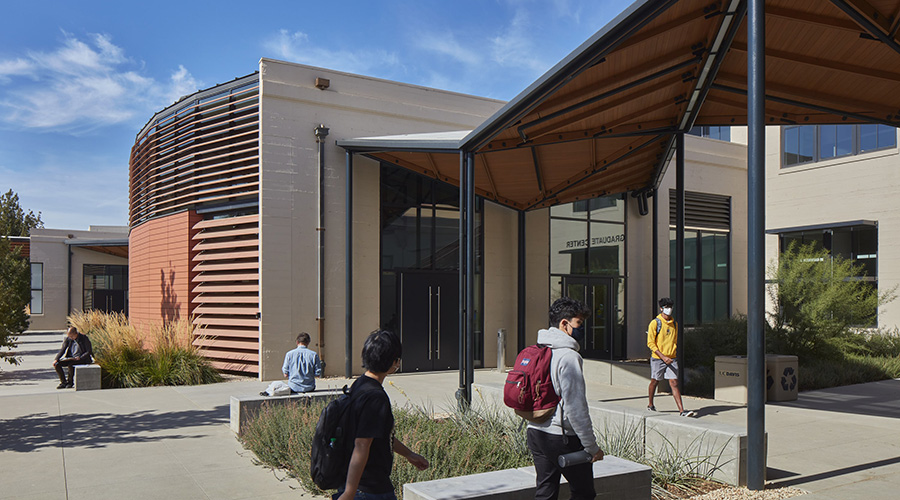Clearing the Air In Classrooms
Managers in K-12 schools speak out on
the challenges of ensuring a healthy indoor environment
Anyone who recalls dissecting frogs in high school biology classes also remembers this much: Formaldehyde stinks. If ever there is a time for efficient filtration and good ventilation, it’s during dissection. All quips about formaldehyde aside, concern over indoor air quality (IAQ) and adequate air filtration in educational facilities is mounting.
Schools in the humid Southeastern United States and the rainy Northwestern United States frequently battle mold. On the plains and in the West, dust and other airborne particulates can present problems. And anywhere food and nesting sites exist, there is the potential for pest infestation. As a point of fact, bad air and sick building syndrome have manifested themselves in so many schools that the U.S. Environmental Protection Agency (EPA) estimates that the problem plagues nearly half of the nation’s schools.
That concern is strongest in K-12 facilities for several reasons. Children are more susceptible to airborne particulates and allergens than other segments of the population, and many elementary and secondary educational facilities rely upon old or outdated HVAC systems that might have filtering inefficiencies.
Although battling poor IAQ at its source is important, appropriate filtration is also critical. Because of these challenges and increasing concern, maintenance and engineering managers in K-12 facilities should make adequate and efficient air filtration a high priority.
Filtration Baselines
Savvy managers know to treat all alleged IAQ complaints promptly and with care to avoid potential health problems and litigation. But before managers can conduct remediation efforts or specify filtration products, they need to quantify IAQ measurements in their facilities.
Charlie Smith, director of maintenance and transportation for the Humboldt County (Nev.) School District brought in a consultant to perform air quality tests three or four years ago.
“It helped me get a baseline for future IAQ measurements,” he says.
Phil Russell, operations manager for the Mapleton (Colo.) School District, says that educators and administrators are increasingly sensitive to air quality. That shift has led Russell to perform some recent testing in his buildings. He also acquired the EPA’s Tools for Schools kit and used the services of Denver Metro’s Tri-County Health organization to test IAQ.
Quick response is also part of the De Soto (Kan.) Unified School District’s plan. Denis Johnson says that when parents were concerned about mold in one of the district’s buildings, administrators hired a consultant to test the air.
“The consultant backed up our suspicions — that the mold count inside the school was actually lower than the outside air,” Johnson says. “It’s nice to have a third party that’s outside of the school district that helps reassure parents and administrators.”
According to Johnson, when there’s a suspicion in his district about poor IAQ, his technicians use the EPA Tools for Schools kit. More information on the kit.
Uncontrollable Variables
Managers need to remember that some areas of their facilities might be prone to higher levels of contamination. For example, classrooms serviced by air intakes located near loading docks or at street level might pull more airborne contaminants into a facility. Similarly, intakes with birds that roost or nest in them might bring more contaminants into a building.
“We’ve had problem rooms in one school,” Russell says. “Those rooms are all on one side of the school with air intakes that face a certain direction.” While administrators aren’t certain what causes the contamination, they replace the filters for those rooms more frequently than the district’s standard 60-day schedule. Russell says those rooms have experienced a significant decline in contamination since instituting more frequent filter changes.
Humboldt County in northwestern Nevada — the county is bigger than Connecticut, Delaware and Rhode Island combined — is inhospitable territory for mold and most pests, though it presents other problems for Smith.
“We’ve got about 13 percent humidity, which means that mold and cockroaches don’t do that well out here.” he says. “Our problems are yellow jackets in the fall and dust. We’ve got a lot of dust.”
Specifying Filtration
Once managers have a baseline for an occupied space and take geographical or environmental limitations into consideration, they should attempt to eradicate the source of the contaminant and then specify appropriate filtration products. Most educational facilities use mechanical panel filters, rather than the complex ion generation filters or other filtering methods required for healthcare or cleanroom environments. While specifying filters is not particularly complicated, managers must be careful to choose filtration most effective for their environment.
“I still use fiberglass filters in some rooms, which sounds horrible, but I only use them in rooms without air conditioning,” says Warren Schmidt, director of facilities, for the West Bend (Wis.) School District. “There’s not much sense in using fancy filters if the classrooms have outside ventilation and openable windows.”
But Schmidt uses pleated filters in rooms serviced by air conditioning.
He first looked into using non-fiberglass filters seven or eight years ago when occupants in three classrooms began to show the same health symptoms.
“That school was built in the mid-60s and those classrooms were all serviced by the same rooftop unit,” Schmidt says. “It was a $28,000 project at the time, but we cleaned all the ductwork, and it was the first time we looked at something other than fiberglass filters. Now we use pleated filters and haven’t had a complaint since.”
Filter Efficiency
Air filters should have a dust-spot rating between 35 and 80 percent, according to the EPA. This efficiency rating is an important aspect of filtration. The higher the filter efficiency rating, the smaller the particles it can remove. Because higher efficiency captures smaller particles, it also retards the passage of air through the ductwork, causing a greater pressure drop in the system than with low-efficiency filters. So it is important for managers to determine the contaminants in the air and the level of filtration necessary to remove them, then adjust the system accordingly. Using a low-efficiency prefilter upstream from the main filter will help managers reduce costs and lengthen filter replacement schedules.
Managers should consult design manuals and building standards, such as ASHRAE Standard 52.2 and Standard 62-1989 for ventilation rates and filter efficiencies. See graph accompanying this article.
Field Observations
Some of the best lessons about filtration don’t come from building manuals or code standards, but rather from hands-on experience in the field.
“I think one of our problems in the past was using cleanable filters that weren’t handled right,” Smith says, adding that they might not have been cleaned appropriately. “Pleated, disposable filters are a lot more efficient and fairly cheap.”
Schmidt, who also uses disposable, pleated filters, says he recently investigated a new type of pleated filter designed to last twice as long as those he is using.
“But I’m not certain that’s a good idea,” he says. “When filters are changed quarterly, it means the guys are up there more frequently, so we have a better chance of catching something before it gets out of hand.” Russell also says that regular filter changes are key to maintaining proper IAQ.
“With older HVAC systems, the key to better air quality is with reliable, frequent filter changes,” he says. Russell’s district recently changed its filter frames to a standard size and contracted out the task of changing filters.
“The standardization has cut our costs, and by contracting out the work, we know that it gets done,” he says. Both Schmidt and Russell said they appreciate outside help with their air filtration efforts.
Johnson says all but one school in his district uses direct digital controls (DDC). While not a filter consideration, Johnson says the system has been very helpful when addressing IAQ concerns.
“DDC controls have been a big help because they can help us maintain a history and measure air flow,” he says.
“I’ve had mold problems before,” Schmidt says. “So I stopped going to the seminars because I often knew as much or more than the folks giving the talks. But the best thing to have is a good consultant that you trust.”
Selected ASHRAE Ventilation Requirements
| Type of Area |
Occupancy |
CFM/person |
|
|
|
(people/1000ft2)
|
|
| Instructional Areas |
|
| Classrooms |
50
|
15
|
|
| Laboratories |
30 |
20 |
|
| Music rooms |
50 |
15 |
|
| Training shops |
30 |
20 |
|
| Staff Areas |
|
| Conference rooms |
50 |
20 |
|
| Offices |
70 |
20 |
|
| Smoking lounges |
7 |
60 |
|
| Assembly Rooms |
|
| Auditoriums |
150 |
15 |
|
| Libraries |
20 |
20 |
|
| Gymnasiums |
|
|
|
| Bleachers |
150 |
15 |
|
| Playing floor |
30 |
20 |
|
| Miscellaneous |
|
| Nurse’s offices |
10 |
25 |
|
| Corridors |
|
0.1 CFM/sq. ft. |
|
| Locker rooms |
|
0.5 CFM/sq. ft. |
|
| Restroom |
|
50 CFM/stall |
|
Recommended CFM rates are per ASHRAE 62-1989, Ventilation Standard for Acceptable Indoor Air Quality. Air filtration can be applied to reduce actual outside air for energy conservation.
Filter efficiencies for the above areas are 20-30 percent (MERV 6-7) for first-stage efficiency; air filter second-stage efficiencies for the above areas should be 60-85 percent (MERV 11), except laboratories, which should have second-stage efficiencies of 85 percent (MERV 13). These requirements are ASHRAE dust spot efficiencies, as per Standard 52.1-1992. Laboratories, locker rooms, restrooms and training shops should be under negative pressure to prevent contamination of adjacent spaces.
|
Related Topics:











